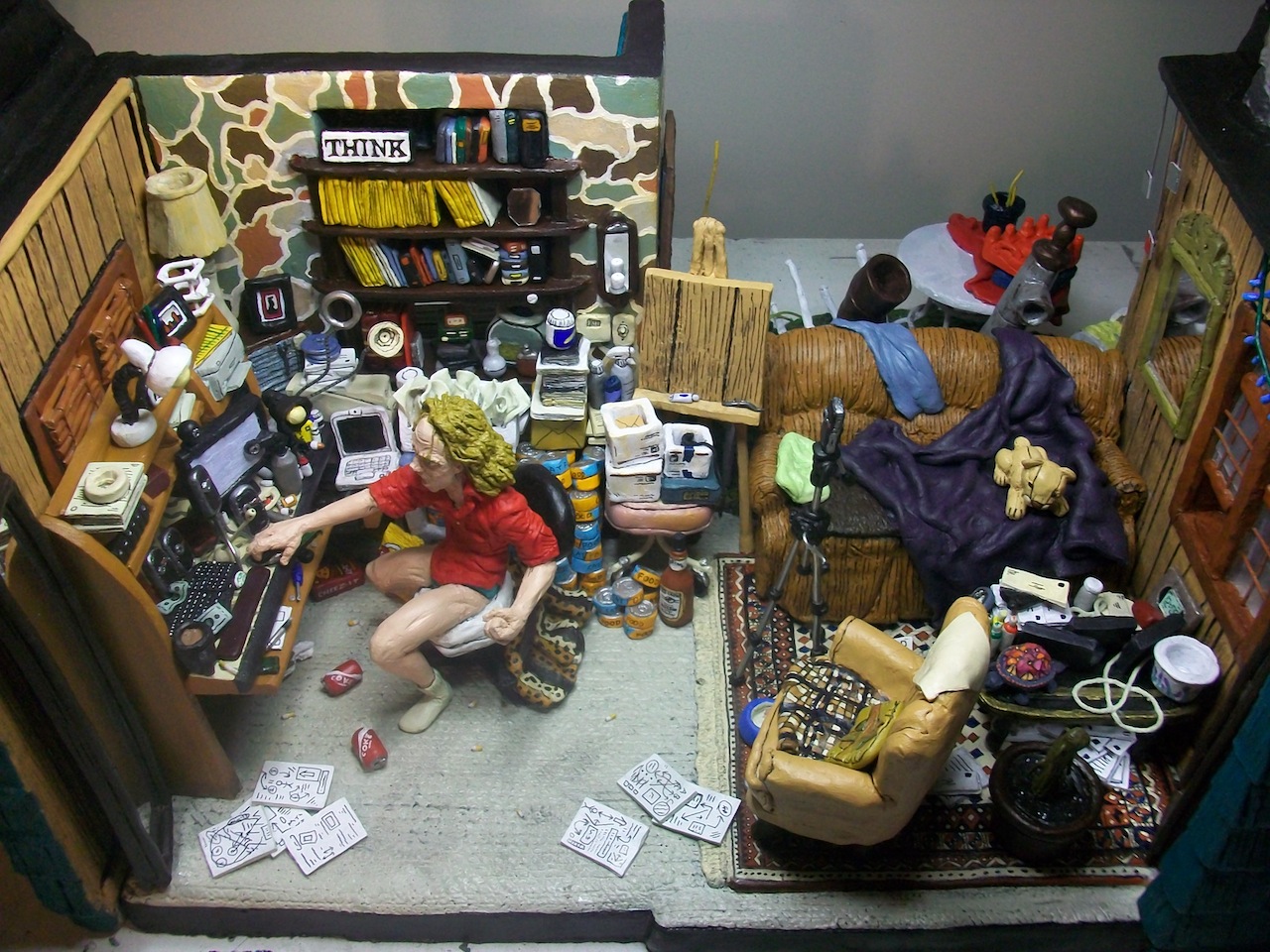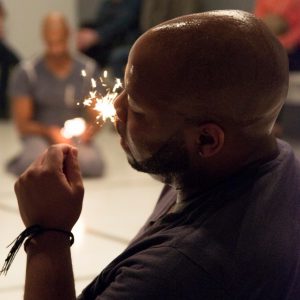Movement Matters investigates work at the intersection of dance, performance, politics, policy and issues related to the body as the locus of these and related socio-cultural dialogues on race, gender, ability and more. For this installment, we sit down with trans performance artist Amanda Sukenick to discuss her belief in the meaningless waste of human existence, her often absurdist identity art personifications, and the path to YouTube stardom that landed her a guest spot on Comedy Central’s Tosh.0.
Michael Workman: Hey, Amanda! Thanks for taking the time to talk with me today. I always think you’re from here, but you actually relocated from the east coast.
Amanda Sukenick: I was born in Long Island, New York in 1983, but my parents and I moved to Chicago when I was three because my father had found a new job here. My dad worked in advertising and he was also an oil painter, and my mother was a psychoanalyst. We traveled back and forth from New York to Chicago a lot, as I still have family there, but I primarily grew up in Chicago, and I deeply believe living here over having had a childhood in suburban Long Island was key to my not developed into an axe wielding maniac. I was severely learning disabled when I was a kid, couldn’t read until I was 10, and still have an understanding of mathematics equivalent to like a 4th grader. So growing up and going to school would have been hard anywhere, and it was, but I loved being a Chicago city kid, and still do. I grew up mainly in the gold coast area, and I first went to school at The Chicago City Day School until the 5th grade, and then I did 8 years at Frances W. Parker. My favorite parts of growing up in Chicago where all the wonderful comic book, toy, video and music stores that have come and gone over the years! Most of my childhood and beyond has been spent obsessing over one thing or another to the exclusion of all else, while making art in seclusion!
MW: How did you initially get interested in performance art? As an artist or in terms of doing it professionally?
AS: I’ve always loved anything to do with theater and performance. My family really did give me a wonderful introduction to many art forms, the performing arts very much included. I have many happy memories of seeing lots of Broadway plays, operas, as well as independent theater of various types. And of course I always loved movies if they count under the banner of performance. Lots and lots of lots of movies.
I did do quite a lot of improv as a kid at Second City, however I never really thought to actively pursue performance or acting or anything of the kind professionally. I genuinely feel that it’s something I’ve fallen into, but very happily so. I honestly didn’t have the confidence much of my life to think of myself as a performer, and also I was very tortured by the idea that I had to pick an art medium and not allow myself to do anything else. For a long time that was drawing, I only allowed myself to draw, and I loved drawing, but I was also deeply unhappy because of it. It wasn’t until I started performing in the form of my video work for Youtube that I was really freed from all that.
It all came about because of my extreme toy collecting habit; for years and years I was completely obsessed by the Manga and Anime, Dragonball Z, particularly, and the thousands of toys that have been released for the franchise. I had and still have an enormous collection of them. In 2008, I became the senior editor for a website called Dragonballtoys.com. Aside from my normal Senior Editor duties which included writing articles, managing the forums, reporting the news, and being the site’s toy archivist, the company that owned the site were really looking for a way to make it popular. To accomplish that, I had the idea to start making toy reviews on Youtube. It was a slow process of truly being able to reveal myself, but for the first time in my life I felt like I wasn’t hiding, and that I didn’t have to hide, I could tell the truth in whatever uglinesses I needed to show. As time went on, my videos transformed from simple reviews of figures, to really becoming quite performative, where I began dressing up as the characters, BADLY, and scaring the hell out of people. And I loved it!
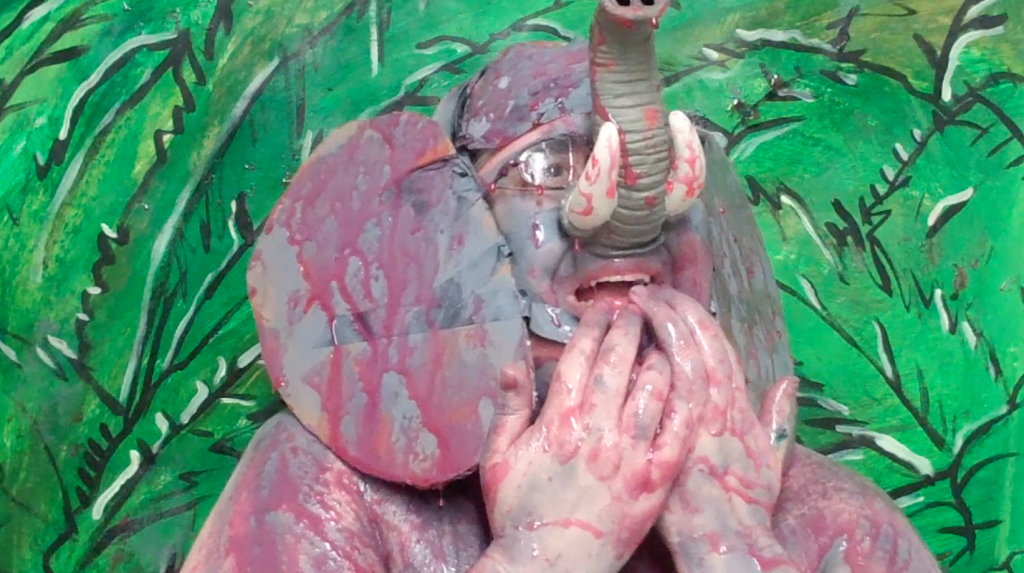
Eventually though, I kind of moved away from making toy videos, and started getting really interested in the Atheist/Philosophy debates on Youtube that started in late 2010. Before my eyes in 2011, all this would develop into the anti-natalist/EFIList movement on the internet, which would be the subjects that have obsessed my work for the last 5 years. I initially had a lot of angst making this transition though, because I had no idea how a non-philosopher, who was terrible at argumentation, could be an activist, and try to contribute to the furthering of ideas like anti-natalism. But then I realized that using humor and performance was a fantastic way of getting people to be able to have a conversation about really difficult, scary subjects like extinction, and that there really was a lot of work that could be done to widen the scope of the conversation through these methods. So, it’s through performance that I think I have realized myself as an activist as well. I will admit, calling myself or even thinking of myself as a performance artist is something I’m honestly still getting used to, but I can scarcely say just how exciting it for me when other people see me that way!
MW: Whom were your inspirations and mentors?
AS: I’m inspired by a lot of things and a lot of people. What’s really inspired me for much of my life are monsters, giant robots, toys, bootlegs, weird movies, Chicago, and light. I would say over the last 5 years my main source of inspiration has come from the people I know, my friends and people that I’ve met and worked with online. The Youtube-based philosopher Inmendham especially. I originally discovered his Vlogs around 2010, and through him and others making videos at the time in our Youtube community, I was first exposed to ideas such as anti-natalism, the idea that it is unethical to procreate, and then later EFIList, which is a variety of anti-natalism invented by Inmendham, which has more to do with sentient life being where the real lack of ethicacy lies, and that sentient life becoming extinct would be the best prescription for the future. So, Inmendham and I have managed to have a very productive friendship over the years. He is very much my muse, and I think I could probably spend the rest of my life making work based on things he’s said and not run out of material. It all started with a sculpture I did of him in his home. Since then, we’ve produced a public access TV show together called Vloggerdome, and I also made a short film called The EFIList based on the philosophy. A great deal of the dialogue in the film are simple reworkings of things that Inmendham has said in his videos; doing this has required both a tremendous amount of archiving and transcribing of his videos, of which there are many thousands. Currently we are slowly working on more projects, including a movie about life itself being on trial.
I also would like to say that I absolutely loved going to college and graduate school at The School of the Art Institute of Chicago. I worked with so, so many people who have had such a wonderful influence over my work as well as the rest of my life. If I had to pick one person that really mentored me though, it would have to have been the great, and now sadly passed Micheal Miller. He taught etching and was a great artist. He, more than anyone, taught me that I didn’t have to have this deductive approach towards my own creativity. If I wanted to be a printmaker for now, good, if I wanted to make movies now, good, if I wanted to do sculpture, good. It was the fact that I could do all of them that was a good thing, not something I had to suffer over. I could finally just enjoy making work. He had a way of bringing out the excitement in people over watching a project unfold. He was brilliant at knowing just how to help lead someone to that project’s fruition. I miss him very much.
MW: You’ve got this interesting nexus of sculpture and performance in your work.
AS: When it comes to sculpture, aesthetically speaking anyway, I would say I’m certainly working in some tradition of toy making, particularly bootleg toys and play sets. This carries over into the video work as well really, especially when I am able to build my own sets. In regards to video art or performance, it would have to be just generally out of a love of strange cinema, but also Youtube and Vine, and the general styles and methods that have come out of online video sharing. If I could accomplish any part of advancing forward a kind of artistic tradition, I guess I would have to say Vlogging, though I admit vlogging is not particularly traditional! I think Vlogging is a very important way for people to communicate with one another, and it’s died a lot over the last few years…Internet debate communities, or just the number of people making videos talking about their lives have seriously declined, and I think that’s terrible. So I would love to find ways of making vlogging important to people again, and I’ve tried to do some of that through my archiving practice. vlogging may have no future, but it most certainly has a past. But sadly much of that past is a broken narrative, as videos on the internet are censored or removed for one reason or another. So what I’ve tried to do is hunt for lost videos, and save as many as possible, and then reassemble the narratives back together in archive sites that I build using Omeka. In regards to a lot of the material I collect, I think that it represents an important part of atheist history, and eventually I hope if I’m able to re-assemble enough of it, it will be recognized as such by a much wider audience.
MW: How you think that veers off into innovation in your work?
AS: Well Antinatalism, though it’s had a very very long history, as has cropped up as an idea throughout time, has never really been combined directly with an arts practice that I know of, and so I think that’s given me a unique opportunity to make the subject known in circles it would otherwise never have found it’s self. When I was a guest of the TV show Tosh.0, it was as far as I know, the very first time Antinatalism had ever been discussed on television by name. I think what I hope to do is sort of a two pathed road in that on one hand I hope to be able to expand the number of people thinking about subjects like EFILism or say, The Right To Die, I hope to be a good activist, but in order to do that I also want and need to be able to sort of champion all the material on those subjects that have come before it, and that have inspired me so much like the work of Inmendham or the sadly deceased DerivedEnergy. So that’s more the work of archiving and re-mixing essentially – finding ways to say the same things but in either a more palatable way, more performative, more consumable perhaps. So that’s made my work extremely collaborative, and I like making work where even though I might be the one putting it all together, I only really represent one cog in whats really an activism engine.
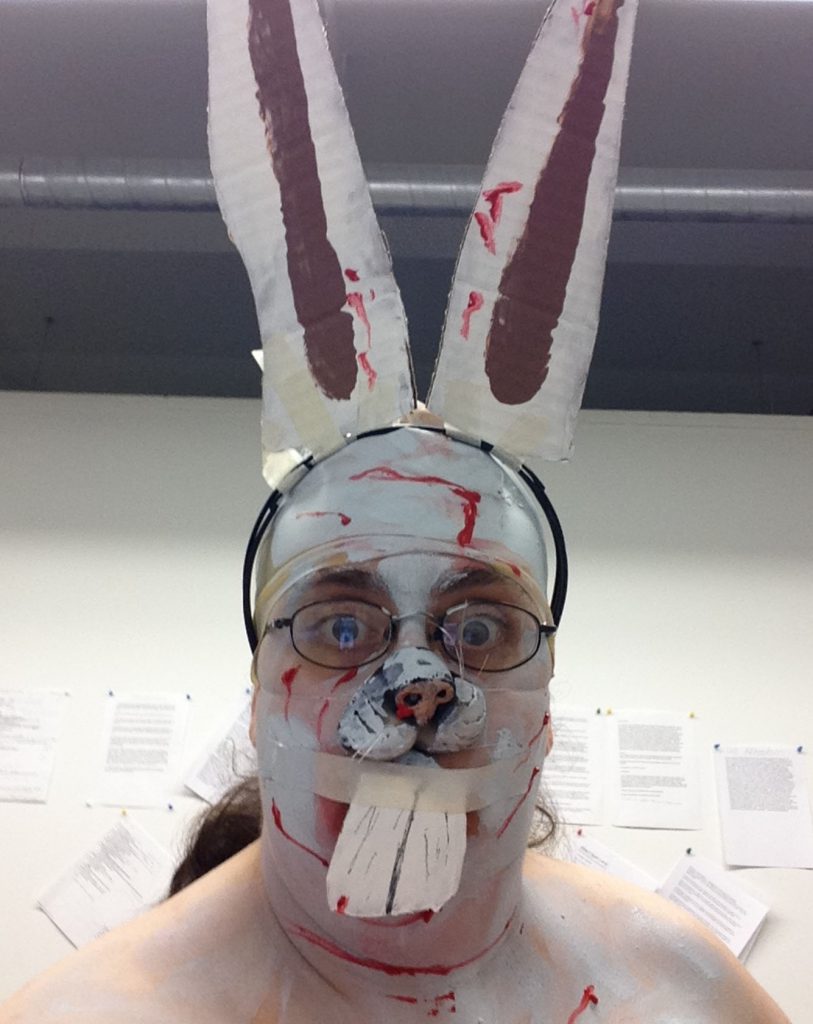
MW: I can see that. There’s this real attempt to push the boundaries emotionally, and experiment with representations of self. And people can react vry negatively to difference, of course.
AS: I think I’ve been most successful where I’ve lost the most fear. When I started making videos I was very frightened that people would know I was fat, or know I was trans-ish, or make fun of me. But then I realized that I just didn’t care as much as I thought I did about what people think or what they might say, and that challenging their bigotries and displeasure through a use of just all out flagrant and unapologetic weirdness made me feel fantastic. I also realized that when people hate you, you have their undivided attention for at least a short while—you have them right where you want them in fact, and while they cringe and while they hate, you can also make them think about something entirely different, you can insert other ideas, that may cause some real cognitive dissidence. Realizing all this has been very important to the work I do. As for things that haven’t work out—well I’m not sure it’s much of an artistic aspiration so to speak, but I’ve spent quite a few portions of my life quite isolated, and though that’s allowed me to produce a lot of work, it hasn’t been a good thing, and it’s very hard to break ones self of.
MW: How did the whole Tosh.0 thing come about? How do you feel about the experience? It looked like a lot of fun.
AS: It was amazingly fun! They were very kind, I had a great time. Over all I’m very happy with the way it finally came out—though I admit I was terrified pretty much until the moment after it finally aired. Because you never know how they are going to edit it, or what they might add to make you look like an even bigger jackass than you already are, ya know? But basically what happened is that all the while I was filming the EFIList, I was continually uploading little bits of the movie on to my Youtube channel, both so that the separate sections of the movie could sort of live their own lives a bit removed from the context of the philosophy and rest of the movie, but also because the spirit of the film is entirely collaborative, and I made as much as possible visible to the rest of the Antinatalist/EFIlist community, so their opinions/suggestions could influence the way the movie movies forward. But in any case, one of the individual parts of the movie that I was quick to upload right away, maybe 30min after I had filmed it was the Baby Elephant scene… And I have to say pretty much no one liked it! But then one day, I noticed it was getting a ton of comments and views all of a sudden, and I quickly learned that it had been shared on Reddit under Cringe. It jumped up to about 30,000 views super quick, and it got around another 20,000 views on Facebook. It was later that day I heard from Tosh.0! I have to say they were amazing about their treatment of the subject matter from the very beginning. When I first spoke with one of their producers, I initially though I had kind of blown it because I could tell he was a bit shocked by the whole Antinatalist angle during our first chat. But the second time I heard from them, they were really excited about it, and told me they had been having some great debates about the philosophy, and I really feel like I kinda lucked out. I was quite concerned how their treatment of the subject and me would turn out though—I didn’t care if they made fun of me, but I have lots of people counting on me not to do something that will harm the movement, and of course Tosh.0, is a show where you, and what you do and stand for can expect to be mocked. But honestly, they were very respectful I felt, they truly stuck with the idea that Antinatalism is about ending suffering in the world, which I feel was key to it being a good piece on the subject. We filmed an interview for about a half hour I think and there were some things I wish they had left in, such as any mention of the film, my screen name (Oldphan), Youtube channel or EFILism—it is a terribly flawed representation of EFIlism, but it being the first time AN was discussed on TV, I’ll take it!
MW: As an self-identified trans and identity artist, what do you feel are the resistances you face in our culture? How do you in your personal practice work to push back against that? What changes need to happen?
AS: I think there’s an incredible difference for transgender people now than it was even when I was a kid, especially I think for F to M people—I can’t tell you how many times I was told that only men ever feel like they should be the opposite gender, and that I pretty much didn’t exist. The ability, at least in some parts of society, to not have to hide ones gender dysphoria is just incredible, and I’m so grateful for those that have fought so hard for transgender rights and freedoms. I suppose I have to say right off the bat though that I’ve always felt rather distant from being transgender as a movement, and part of that simply has to do with the fact that I had almost no contact with other trans people until I was around I don’t know, 28? But of course the internet changed that for me, and when it comes to Youtube, that site is just an absolutely incredible tool for feeling less alone as a transgender person. As far as resistances, well I think I’m very confusing for a lot of people because even though I do identify as trans, I have no plans on transitioning, I wouldn’t be caught dead telling people to mind their pronouns—I would rather stand as a broken monster in this world than something having to have all this rehabilitation, all this metamorphosis—I’m already Frankenstein, and no amount of surgery and pills is going to change that. I hope in my own way to highlight that there is something fascinatingly Antinatalistic about being transgender in my opinion, it is often a very very clear limnation of one’s birth—however for most transgender people it seems to be more about, “who I am becoming,” rather than the sentiment of “better never to have been,” which is more how I feel. I think in it’s way, Antinatalism has allowed me to think beyond gender more than I ever had before, and make more of a critique about life itself—life is an unacceptable waste no matter what, and I would love to somehow make that more of a conversation among transgender people.
Please feel free to send questions, comments or tips to Michael Workman at michael.workman1@gmail.com. As part of the Movement Matters series, a monthly online conversation on subjects discussed in the column will take place starting with The Integral Necessity of Dance Criticism on Dec. 15, 6:30-9:30pm at High Concept Laboratories (2233 S. Throop St., Chicago). Please join the Movement Matters Facebook page for updates, and to join in on future online conversations.
Featured Image: Courtesy of the artist.
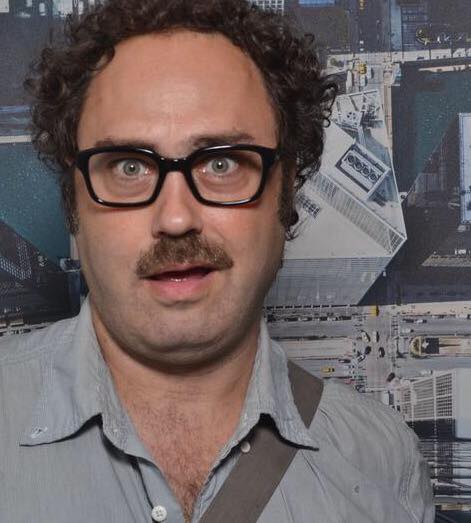 Michael Workman is an artist, writer, dance, performance art and sociocultural critic, theorist, dramaturge, choreographer, reporter, poet, novelist and curator of numerous art, literary and theatrical productions over the years. In addition to his work at The Guardian US, Newcity, Sixty and elsewhere, Workman has also served as a reporter for WBEZ Chicago Public Radio, and as Chicago correspondent for Italian art magazine Flash Art. He is also Director of Bridge, a Chicago-based 501 c (3) publishing and programming organization. You can follow his daily antics on Facebook.
Michael Workman is an artist, writer, dance, performance art and sociocultural critic, theorist, dramaturge, choreographer, reporter, poet, novelist and curator of numerous art, literary and theatrical productions over the years. In addition to his work at The Guardian US, Newcity, Sixty and elsewhere, Workman has also served as a reporter for WBEZ Chicago Public Radio, and as Chicago correspondent for Italian art magazine Flash Art. He is also Director of Bridge, a Chicago-based 501 c (3) publishing and programming organization. You can follow his daily antics on Facebook.
